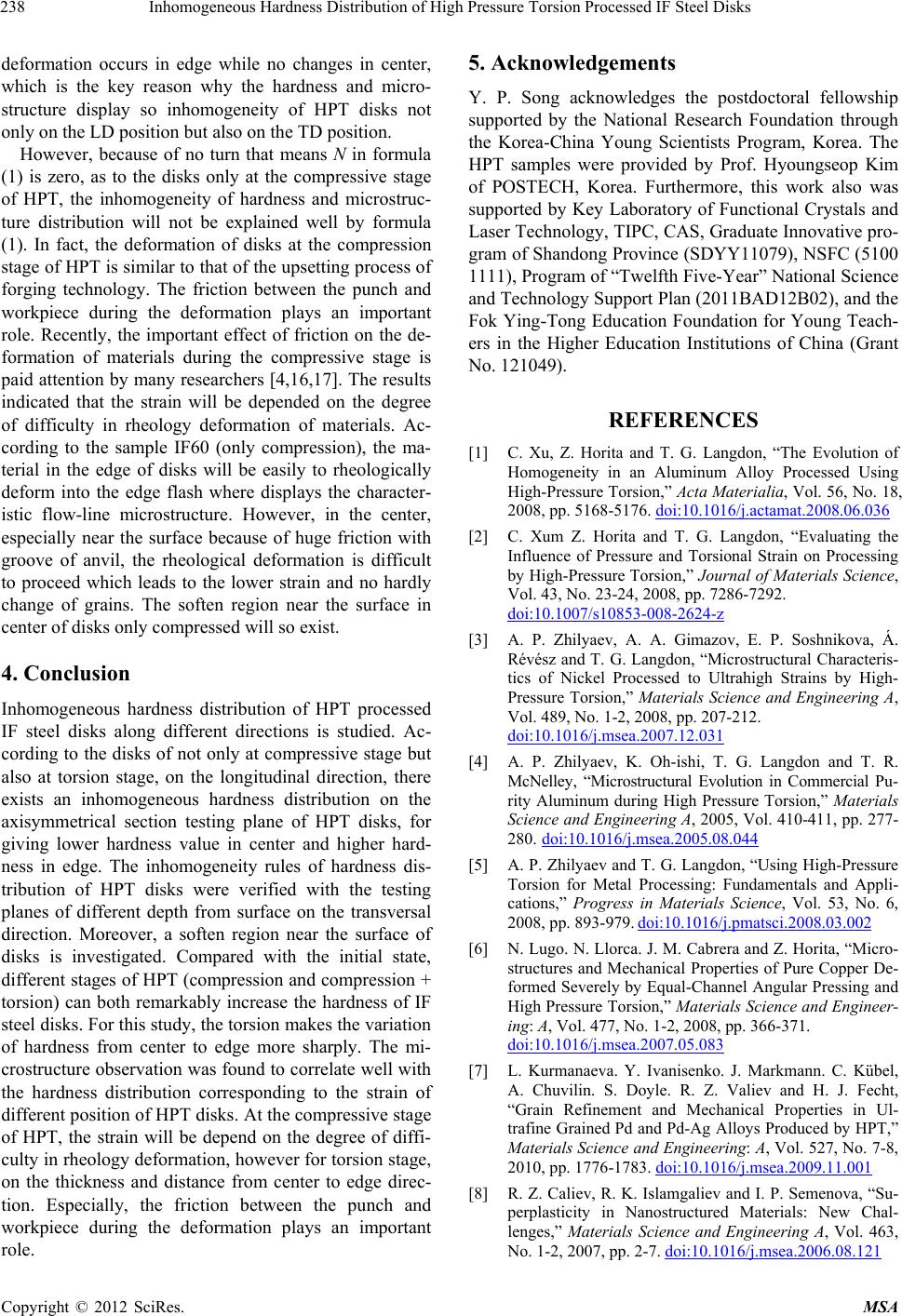
Inhomogeneous Hardness Distribution of High Pressure Torsion Processed IF Steel Disks
238
deformation occurs in edge while no changes in center,
which is the key reason why the hardness and micro-
structure display so inhomogeneity of HPT disks not
only on the LD position but also on the TD position.
However, because of no turn that means N in formula
(1) is zero, as to the disks only at the compressive stage
of HPT, the inhomogeneity of hardness and microstruc-
ture distribution will not be explained well by formula
(1). In fact, the deformation of disks at the compression
stage of HPT is similar to that of the upsetting process of
forging technology. The friction between the punch and
workpiece during the deformation plays an important
role. Recently, the important effect of friction on the de-
formation of materials during the compressive stage is
paid attention by many researchers [4,16,17]. The results
indicated that the strain will be depended on the degree
of difficulty in rheology deformation of materials. Ac-
cording to the sample IF60 (only compression), the ma-
terial in the edge of disks will be easily to rheologically
deform into the edge flash where displays the character-
istic flow-line microstructure. However, in the center,
especially near the surface because of huge friction with
groove of anvil, the rheological deformation is difficult
to proceed which leads to the lower strain and no hardly
change of grains. The soften region near the surface in
center of disks only compressed will so exist.
4. Conclusion
Inhomogeneous hardness distribution of HPT processed
IF steel disks along different directions is studied. Ac-
cording to the disks of not only at compressive stage but
also at torsion stage, on the longitudinal direction, there
exists an inhomogeneous hardness distribution on the
axisymmetrical section testing plane of HPT disks, for
giving lower hardness value in center and higher hard-
ness in edge. The inhomogeneity rules of hardness dis-
tribution of HPT disks were verified with the testing
planes of different depth from surface on the transversal
direction. Moreover, a soften region near the surface of
disks is investigated. Compared with the initial state,
different stages of HPT (compression and compression +
torsion) can both remarkably increase the hardness of IF
steel disks. For this study, the torsion makes the variation
of hardness from center to edge more sharply. The mi-
crostructure observation was found to correlate well with
the hardness distribution corresponding to the strain of
different position of HPT disks. At the compressive stage
of HPT, the strain will be depend on the degree of diffi-
culty in rheology deformation, however for torsion stage,
on the thickness and distance from center to edge direc-
tion. Especially, the friction between the punch and
workpiece during the deformation plays an important
role.
5. Acknowledgements
Y. P. Song acknowledges the postdoctoral fellowship
supported by the National Research Foundation through
the Korea-China Young Scientists Program, Korea. The
HPT samples were provided by Prof. Hyoungseop Kim
of POSTECH, Korea. Furthermore, this work also was
supported by Key Laboratory of Functional Crystals and
Laser Technology, TIPC, CAS, Graduate Innovative pro-
gram of Shandong Province (SDYY11079), NSFC (5100
1111), Program of “Twelfth Five-Year” National Science
and Technology Support Plan (2011BAD12B02), and the
Fok Ying-Tong Education Foundation for Young Teach-
ers in the Higher Education Institutions of China (Grant
No. 121049).
REFERENCES
[1] C. Xu, Z. Horita and T. G. Langdon, “The Evolution of
Homogeneity in an Aluminum Alloy Processed Using
High-Pressure Torsion,” Acta Materialia, Vol. 56, No. 18,
2008, pp. 5168-5176. doi:10.1016/j.actamat.2008.06.036
[2] C. Xum Z. Horita and T. G. Langdon, “Evaluating the
Influence of Pressure and Torsional Strain on Processing
by High-Pressure Torsion,” Journal of Materials Science,
Vol. 43, No. 23-24, 2008, pp. 7286-7292.
doi:10.1007/s10853-008-2624-z
[3] A. P. Zhilyaev, A. A. Gimazov, E. P. Soshnikova, Á.
Révész and T. G. Langdon, “Microstructural Characteris-
tics of Nickel Processed to Ultrahigh Strains by High-
Pressure Torsion,” Materials Science and Engineering A,
Vol. 489, No. 1-2, 2008, pp. 207-212.
doi:10.1016/j.msea.2007.12.031
[4] A. P. Zhilyaev, K. Oh-ishi, T. G. Langdon and T. R.
McNelley, “Microstructural Evolution in Commercial Pu-
rity Aluminum during High Pressure Torsion,” Materials
Science and Engineering A, 2005, Vol. 410-411, pp. 277-
280. doi:10.1016/j.msea.2005.08.044
[5] A. P. Zhilyaev and T. G. Langdon, “Using High-Pressure
Torsion for Metal Processing: Fundamentals and Appli-
cations,” Progress in Materials Science, Vol. 53, No. 6,
2008, pp. 893-979. doi:10.1016/j.pmatsci.2008.03.002
[6] N. Lugo. N. Llorca. J. M. Cabrera and Z. Horita, “Micro-
structures and Mechanical Properties of Pure Copper De-
formed Severely by Equal-Channel Angular Pressing and
High Pressure Torsion,” Materials Science and Engineer-
ing: A, Vol. 477, No. 1-2, 2008, pp. 366-371.
doi:10.1016/j.msea.2007.05.083
[7] L. Kurmanaeva. Y. Ivanisenko. J. Markmann. C. Kübel,
A. Chuvilin. S. Doyle. R. Z. Valiev and H. J. Fecht,
“Grain Refinement and Mechanical Properties in Ul-
trafine Grained Pd and Pd-Ag Alloys Produced by HPT,”
Materials Science and Engineering: A, Vol. 527, No. 7-8,
2010, pp. 1776-1783. doi:10.1016/j.msea.2009.11.001
[8] R. Z. Caliev, R. K. Islamgaliev and I. P. Semenova, “Su-
perplasticity in Nanostructured Materials: New Chal-
lenges,” Materials Science and Engineering A, Vol. 463,
No. 1-2, 2007, pp. 2-7. doi:10.1016/j.msea.2006.08.121
Copyright © 2012 SciRes. MSA